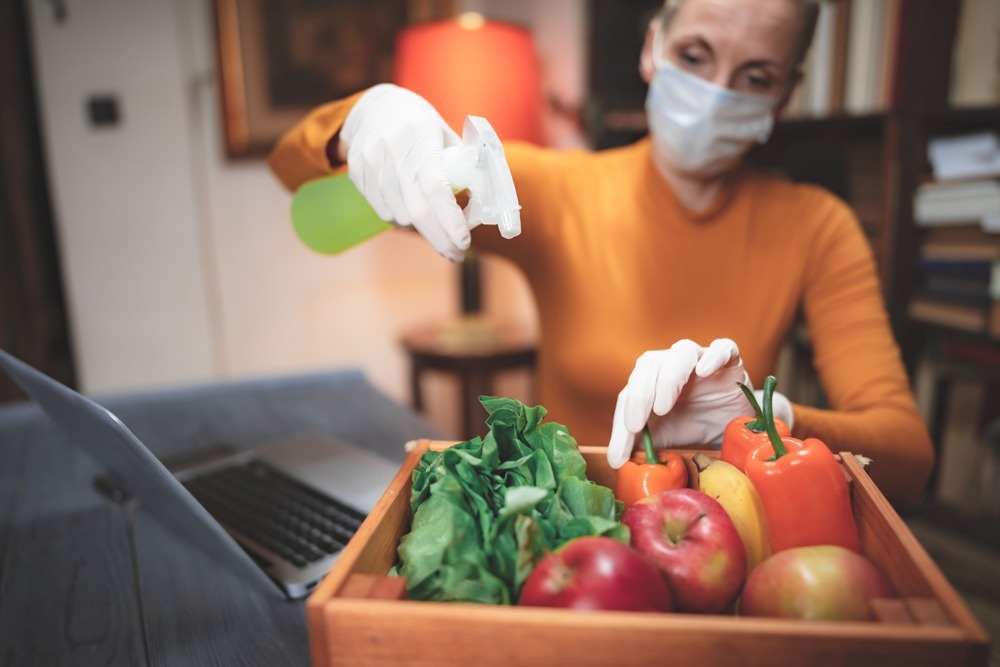A recent Food Microbiology journal study explores the viability of the severe acute respiratory syndrome coronavirus 2 (SARS-CoV-2) on food items and what treatments may inactivate the virus from these products.

Study: Viability of SARS-CoV-2 on lettuce, chicken, and salmon and its inactivation by peracetic acid, ethanol, and chlorine dioxide. Image Credit: AstroStar / Shutterstock.com
Background
SARS-CoV-2, the causative pathogen of the coronavirus disease 2019 (COVID-19) pandemic, is a betacoronavirus that primarily spreads through respiratory droplets and aerosols.
The seafood market in Wuhan, China, is considered the initial source of SARS-CoV-2. About 55% of China's COVID-19 cases detected in December 2019 were associated with this market.
Several studies have linked other COVID-19 outbreaks with virus-contaminated frozen foods and food packaging materials. These observations have raised global concern over food safety during the pandemic.
In the current study, scientists assess the viability of SARS-CoV-2 on three food items stored at different temperatures. They also determine the potency of three disinfectants in inactivating the virus on food items.
Study design
Three food items were selected for the viral viability test: lettuce, chicken, and salmon. The food items were then contaminated with SARS-CoV-2 and stored at 20 °C (room temperature), 4 °C (refrigerated), and -40 °C (frozen).
For the virus inactivation test, food-grade ethanol, chlorine dioxide, and peracetic acid were selected as disinfectants. Except for ethanol, which was used at 30%, 50%, and 70% concentrations, the other two disinfectants were used at three different concentrations, including the recommended concentration and half and twice the recommended concentration.
Viability of SARS-CoV-2 on food items
The lowest viability of SARS-CoV-2 on food items was observed at room temperature. No detectable viral titers were obtained on any food items after 48 hours of contamination. Among various food items, the highest half-life of SARS-CoV-2 was observed on salmon, followed by chicken and lettuce.
A significant induction in viability was observed at 4 °C. The highest viability at 4 °C was observed on salmon, where SARS-CoV-2 remained infectious for up to 14 days following contamination. On lettuce and chicken, SARS-CoV-2 remained detectable for up to 10 days.
A five- to nine-fold induction in the virus half-life was observed at 4 °C compared to that observed at room temperature. The highest half-life was observed on salmon, followed by chicken and lettuce.
At freezing temperatures, SARS-CoV-2 remained viable for up to four weeks on the tested food items. Significant induction of more than 30-fold in the viral half-life was also observed on each food item.
Inactivation of SARS-CoV-2 by disinfectants
Short-term exposure of one minute to 70% ethanol effectively inactivated SARS-CoV-2 on lettuce but failed to do the same on chicken and salmon. The inactivation of the virus on chicken and salmon was observed after a five-minute exposure to 70% ethanol.
No significant virus-inactivating effect was observed for chlorine dioxide at all tested concentrations and exposure periods. At the highest concentration and exposure time, chlorine dioxide was found to reduce viral infectivity to a certain level only on lettuce.
In contrast to chlorine dioxide, peracetic acid showed significantly higher potency in inactivating SARS-CoV-2 on food items. Specifically, peracetic acid completely inactivated the virus at twice the recommended concentration on each tested food item.
Study significance
The study findings indicate that the viability of SARS-CoV-2 on food items increases more than 30 times at freezing temperatures compared to room temperature. In addition to storage temperature, viral viability also depends on the type of food.
Two viral variants have been studied here, including SARS-CoV-2 S and SARS-CoV-2 L. SARS-CoV-2 L shows higher viability on food items than SARS-CoV-2 S. However, peracetic acid was identified as a highly effective disinfectant that can completely inactivate both viral variants on food items.
The highest potency of peracetic acid was observed at two times higher than the recommended concentration. However, no antiviral efficacy of chlorine-based disinfectants was observed in the study.
- Jung, S., Yeo, D., Wang, Z., et al. (2022). Viability of SARS-CoV-2 on lettuce, chicken, and salmon and its inactivation by peracetic acid, ethanol, and chlorine dioxide. Food Microbiology. doi:10.1016/j.fm.2022.104164
Posted in: Medical Science News | Medical Research News | Disease/Infection News
Tags: Contamination, Coronavirus, Coronavirus Disease COVID-19, covid-19, Disinfectant, Efficacy, Ethanol, Food, Food Safety, Microbiology, Pandemic, Pathogen, Respiratory, SARS, SARS-CoV-2, Severe Acute Respiratory, Severe Acute Respiratory Syndrome, Syndrome, Virus

Written by
Dr. Sanchari Sinha Dutta
Dr. Sanchari Sinha Dutta is a science communicator who believes in spreading the power of science in every corner of the world. She has a Bachelor of Science (B.Sc.) degree and a Master's of Science (M.Sc.) in biology and human physiology. Following her Master's degree, Sanchari went on to study a Ph.D. in human physiology. She has authored more than 10 original research articles, all of which have been published in world renowned international journals.
Source: Read Full Article
